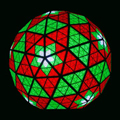As the famous ball dropped 400 feet at NYC’s New Year’s celebration in Times Square, it ushered in a new era of lighting efficiency in the US.
As of 12:01AM on January 1st, EISA (Energy Independence & Security Act 2007) legislation is in effect, which simply requires incandescent bulbs to be 30% more efficient, and encourages development of much more efficient halogens and LEDs.
This year’s Times Square Ball, designed by Waterford Crystall and built by Philips, is a geodesic dome 12 feet in diameter and
weighing 11,875 pounds.

The Ball, which sits at the top of Times Square throughout the year, consists of 32,256 Philips Luxeon Rebel LEDs, each of which can be digitally controlled to create
extraordinary effects. The bulbs use just 22 watts of electricity and last about 30,000 hours, 88% less than previous Balls.
Philips has built the Times Square Ball for 12 years, and considers this year’s lighting technology to be a culmination of recent advances in LED lighting.
California’s Green HOV Decals
In July, California hybrid drivers lost a coveted perk – permission to drive alone in HOV lanes. Instead, 15,000 people have decals for their electric cars (ZEVs), mostly the Nissan Leaf.
Now, the state plans to give those green decals to people who drive near zero-emission cars (PZEVs), but none of them have hit the showrooms yet.
The first cars to meet the new standards are the 2012 Toyota
Prius plug-in hybrid and 2012 Chevy Volt, which will be available in the next three months. Both companies are currently taking orders for those cars.
When they do, the state will limit the green decals they hand out to 40,000 cars, and the program expires in 2015.
Solo entry in the HOV lane, combined with state tax credits, are intended to help compensate for the higher cost of new-generation vehicles, and help get people "over the hump" to accept these new vehicles.
Xmas Trees Become Biofuel
If you live in San Francisco and put your Xmas tree on the curb for "Treecycling," it will be ground into chips and turned into biofuel.
Recology SF collects Xmas trees to keep them out of landfills, where they would generate methane as they decompose. This year, they’ll sell the wood chips to nearby cogeneration plants for energy.
Because fir trees have high acid content, they can’t be mixed with regular compost. Last year, Recology collected about 514 tons of trees.
Although this method for disposing the trees is the best choice available, chipping them does produce emissions, as does burning the resulting biofuel.
The best choice, says Recology, is to rent a native tree from an organization like Friends of the Urban Forest and then return it to be planted in the city after the holiday season.
